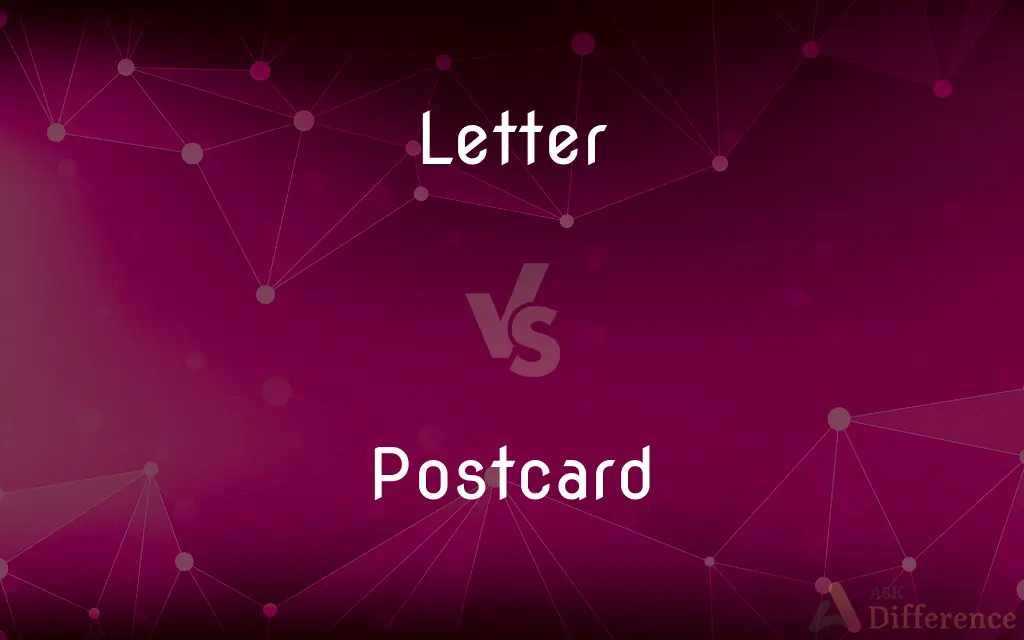Letter vs. Postcard — What's the Difference?
Edited by Tayyaba Rehman — By Urooj Arif — Updated on March 8, 2024
A letter is a written message enclosed in an envelope, offering privacy, while a postcard is an open-format message, designed for brief notes and often featuring an image.

Difference Between Letter and Postcard
Table of Contents
ADVERTISEMENT
Key Differences
Letters are typically composed on paper and placed inside an envelope, ensuring the content remains private until the recipient opens it. This format is suitable for longer, more personal, or confidential communications. In contrast, postcards are single sheets of cardstock with a designated space for a message on one side and an address on the other, alongside a picture or design. Postcards are meant for shorter, less private messages and are often used as souvenirs or to share travel experiences.
While letters allow for extensive detail and elaboration in communication, making them ideal for in-depth conversations, legal matters, or personal correspondence, postcards offer a more concise means of communication. The limited space on a postcard encourages brevity and is often used for greetings, quick updates, or tourism-related purposes. Additionally, the visual element of postcards adds a unique touch, conveying messages through images as well as words.
The cost of sending a letter can vary based on weight and destination, typically requiring more postage than a postcard. This makes postcards a cost-effective option for sending short messages or greetings, especially from abroad. Furthermore, the simplicity of sending postcards, without the need for an envelope, appeals to those looking for an easy and quick way to communicate.
From a recipient's perspective, receiving a letter might signify importance or a personal touch, given the effort involved in writing, enclosing, and mailing it. On the other hand, postcards often bring a sense of joy and surprise, offering a glimpse into the sender's travels or experiences with their visual appeal and succinct message.
The tradition of letter writing has historical significance, being a primary mode of long-distance communication for centuries. Postcards, while also having a rich history, have been more associated with the tourism industry and casual communication, reflecting cultural and societal shifts in how people choose to share their experiences and stay in touch.
ADVERTISEMENT
Comparison Chart
Format
Enclosed in an envelope
Open format with an image and message space
Privacy
Private
Public
Content Length
Long, detailed
Short, concise
Purpose
In-depth communication, privacy needed
Quick updates, tourism, greetings
Cost
Varies by weight; generally more expensive
Typically less expensive
Postal Requirements
Envelope, address inside, variable postage
No envelope, fixed postage, address on the back
Recipient Perception
Personal, significant
Casual, visually appealing
Historical Use
Formal, primary method of communication
Informal, associated with tourism and casual use
Compare with Definitions
Letter
Conveys private or confidential messages.
The attorney mailed the letter containing sensitive information.
Postcard
Offers a visual element to messages.
The postcard featured a stunning view of the Eiffel Tower.
Letter
Allows for detailed expression.
His letter detailed his experiences during his travels.
Postcard
Card for brief messages, often with an image.
I received a beautiful postcard from Italy.
Letter
Written communication in an envelope.
She sent a heartfelt letter to her friend abroad.
Postcard
Convenient for travel communication.
He collects postcards from every city he visits.
Letter
Can be formal or personal.
The job application required a formal cover letter.
Postcard
Requires fixed postage.
She stamped the postcard with a global stamp for international mailing.
Letter
Requires postage based on weight.
She added extra postage to the letter because it included photos.
Postcard
Used for greetings and quick notes.
Sending postcards is her way of saying she's thinking of you.
Letter
A character representing one or more of the sounds used in speech; any of the symbols of an alphabet
A capital letter
Postcard
See postal card.
Letter
A written, typed, or printed communication, sent in an envelope by post or messenger
He sent a letter to Mrs Falconer
Postcard
(transitive) To send a postcard to.
To postcard one's friends
Letter
The precise terms of a statement or requirement; the strict verbal interpretation
We must keep the spirit of the law as well as the letter
The officer in the incident got in trouble for following the letter of the law
Postcard
A postcard or post card is a piece of thick paper or thin cardboard, typically rectangular, intended for writing and mailing without an envelope. Non-rectangular shapes may also be used but are rare.
Letter
Literature
The world of letters
Postcard
A printed card with space on one side for an address and a postage stamp, used for sending a short message through the mail.
Letter
A style of typeface.
Postcard
A rectangular piece of thick paper or thin cardboard intended to be written on and mailed without an envelope. In the case of a picture postcard one side carries a picture or photograph.
Letter
Inscribe letters or writing on
Her name was lettered in gold
Postcard
(transitive) To send by means of a postcard.
To postcard one's news
Letter
Be given a school or college initial as a mark of proficiency in sport
In high school she lettered in soccer, basketball and softball
Postcard
A card for sending messages by post without an envelope
Letter
A written symbol or character representing a speech sound and being a component of an alphabet.
Letter
A written symbol or character used in the graphemic representation of a word, such as the h in Thames. See Note at Thames.
Letter
A written or printed communication directed to a person or organization.
Letter
Often letters A certified document granting rights to its bearer.
Letter
Literal meaning
Had to adhere to the letter of the law.
Letter
Literary culture; belles-lettres.
Letter
Learning or knowledge, especially of literature.
Letter
Literature or writing as a profession.
Letter
A piece of type that prints a single character.
Letter
A specific style of type.
Letter
The characters in one style of type.
Letter
An emblem in the shape of the initial of a school awarded for outstanding performance, especially in varsity athletics.
Letter
To write letters on
Lettered the paper.
Letter
To write in letters
Lettered our name on the mailbox.
Letter
To write or form letters.
Letter
To earn a school letter, as for outstanding athletic achievement
She lettered in three collegiate sports.
Letter
A symbol in an alphabet.
There are twenty-six letters in the English alphabet.
Letter
A written or printed communication, generally longer and more formal than a note.
I wrote a letter to my sister about my life.
Letter
The literal meaning of something, as distinguished from its intended and remoter meaning (the spirit).
Letter
Literature.
Benjamin Franklin was multiskilled – a scientist, politician and a man of letters.
Letter
(law) A division unit of a piece of law marked by a letter of the alphabet.
Letter (b) constitutes an exception to this provision.
Letter
A size of paper, 8½ in × 11 in (215.9 mm × 279.4 mm, US paper sizes rounded to the nearest 5 mm).
Letter
A size of paper, 215 mm × 280 mm.
Letter
Clipping of varsity letter
Letter
A single type; type, collectively; a style of type.
Letter
(archaic) One who retards or hinders.
Letter
(transitive) To print, inscribe, or paint letters on something.
Letter
To earn a varsity letter (award).
Letter
One who lets or permits; one who lets anything for hire.
Letter
One who retards or hinders.
Letter
A mark or character used as the representative of a sound, or of an articulation of the human organs of speech; a first element of written language.
And a superscription also was written over him in letters of Greek, and Latin, and Hebrew.
Letter
A written or printed communication; a message expressed in intelligible characters on something adapted to conveyance, as paper, parchment, etc.; an epistle.
The style of letters ought to be free, easy, and natural.
Letter
A writing; an inscription.
None could expound what this letter meant.
Letter
Verbal expression; literal statement or meaning; exact signification or requirement.
We must observe the letter of the law, without doing violence to the reason of the law and the intention of the lawgiver.
I broke the letter of it to keep the sense.
Letter
A single type; type, collectively; a style of type.
Under these buildings . . . was the king's printing house, and that famous letter so much esteemed.
Letter
Learning; erudition; as, a man of letters.
Letter
A letter; an epistle.
Letter
A telegram longer than an ordinary message sent at rates lower than the standard message rate in consideration of its being sent and delivered subject to priority in service of regular messages. Such telegrams are called by the Western Union Company day letters, or night letters according to the time of sending, and by The Postal Telegraph Company day lettergrams, or night lettergrams.
A strange lock that opens with AMEN.
Letter
To impress with letters; to mark with letters or words; as, a book gilt and lettered.
Letter
A written message addressed to a person or organization;
Mailed an indignant letter to the editor
Letter
The conventional characters of the alphabet used to represent speech;
His grandmother taught him his letters
Letter
A strictly literal interpretation (as distinct from the intention);
He followed instructions to the letter
He obeyed the letter of the law
Letter
An award earned by participation in a school sport;
He won letters in three sports
Letter
Owner who lets another person use something (housing usually) for hire
Letter
Win an athletic letter
Letter
Set down or print with letters
Letter
Mark letters on or mark with letters
Common Curiosities
How does the cost of sending a letter compare to a postcard?
Sending a letter generally costs more due to weight, whereas postcards have a fixed, lower postage rate.
Can letters and postcards be used interchangeably?
They serve different purposes; letters for longer, private communications and postcards for brief, visual messages.
Why choose a postcard over a letter?
For quick, visual communication, especially from travels, a postcard is more suitable and cost-effective.
Can I include pictures in a letter?
Yes, you can include pictures or other items in a letter, which may affect the postage cost due to weight.
How do I know how much postage to use for a letter?
Postage for letters depends on weight and destination; check with the postal service for accurate rates.
Are postcards only for tourists?
While popular among tourists, postcards are also used for casual greetings, collections, or artistic purposes.
How does the visual aspect of postcards enhance communication?
The images on postcards add context and emotional value to the message, making it more memorable.
Can businesses use letters and postcards?
Yes, businesses use letters for formal communications and postcards for marketing or casual updates.
What's the main difference between a letter and a postcard?
A letter is private and enclosed in an envelope, while a postcard is open, offering a brief message and an image.
Do letters offer more privacy than postcards?
Yes, letters are enclosed and offer privacy, unlike postcards, which are open for anyone to read.
Why might someone prefer receiving a letter to a postcard?
Letters can convey more depth and privacy, making them more personal and meaningful.
Is writing letters becoming obsolete?
While less common in the digital age, letters retain their value for personal, formal, or legal communications.
What makes postcards appealing to collectors?
The unique images, historical significance, and the variety of designs make postcards appealing to collectors.
What role do letters and postcards play in today's digital world?
They provide a tangible, personal touch in communication, offering a break from the digital overload.
How do environmental concerns affect the use of letters and postcards?
Both impact the environment, but digital communication offers a more eco-friendly alternative.
Share Your Discovery

Previous Comparison
Poopie vs. Poopy
Next Comparison
Villain vs. VillanAuthor Spotlight
Written by
Urooj ArifUrooj is a skilled content writer at Ask Difference, known for her exceptional ability to simplify complex topics into engaging and informative content. With a passion for research and a flair for clear, concise writing, she consistently delivers articles that resonate with our diverse audience.
Edited by
Tayyaba RehmanTayyaba Rehman is a distinguished writer, currently serving as a primary contributor to askdifference.com. As a researcher in semantics and etymology, Tayyaba's passion for the complexity of languages and their distinctions has found a perfect home on the platform. Tayyaba delves into the intricacies of language, distinguishing between commonly confused words and phrases, thereby providing clarity for readers worldwide.















































